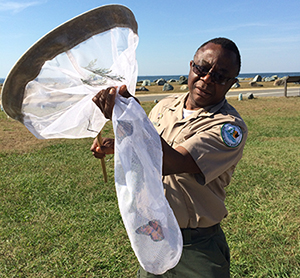Well, it’s that time of year again here in Maryland. Time to migrate! When you hear the word migrate, you probably think of birds, or maybe even fish, and you are correct that these animals do migrate. But did you know that Monarch Butterflies also migrate?
The Monarch Butterflies that you are seeing here in Maryland during the late summer and early fall will spend their winter in Mexico! You’re probably thinking “now how can you be so sure that these Monarchs in Maryland are really going to Mexico? Maybe there are just Monarch Butterflies in both locations at different times.”
Well, thanks to a Citizen Science program called Monarch Watch, for the past 20+ years scientists (and some of our Park Rangers, too!) have been “tagging” butterflies, by placing a tiny little sticker with letters and numbers on them, and sure enough the tagged butterflies have been recovered in Mexico!
 This data is helping scientists to learn more about the Monarch’s migration pathways, as well as about their overall populations. Just this past spring one of the Monarch Butterflies that had been tagged at Gunpowder Falls State Park during the previous fall XBR851 (see photo for monarch tag close up) was recovered on top of Sierra Chincua, a Monarch Sanctuary in the mountains of Mexico- over 2,000 miles away from Maryland!
This data is helping scientists to learn more about the Monarch’s migration pathways, as well as about their overall populations. Just this past spring one of the Monarch Butterflies that had been tagged at Gunpowder Falls State Park during the previous fall XBR851 (see photo for monarch tag close up) was recovered on top of Sierra Chincua, a Monarch Sanctuary in the mountains of Mexico- over 2,000 miles away from Maryland!
Only about 1 out of 1,000 monarch butterfly tags are recovered, so this was quite exciting! Perhaps we will have another recovery this year? Now is a great time to learn more about Monarch Butterflies in Maryland’s State Parks. Come visit one of these Maryland State Parks and talk to a Ranger about Monarch Butterflies. Call ahead to find out if any Monarch Tagging is scheduled and you may be able to help! It is quite a thrill to be able to release a tagged butterfly!
 If you’re not able to visit a State Park to look for Monarchs, you can also bring the butterflies to you! If you would like to have Monarchs in your own backyard, you will need to make sure that you have both the host plant for the caterpillars and nectar sources for the adult butterflies. The Monarch host plant is Milkweed, which as its name states is commonly found as a “weed” along roadsides, ditches and fields throughout most of the state. It is important that we wait to mow these areas until after Monarchs have left Maryland in the fall. Milkweed is the only type of plant that the caterpillars feed on. So no milkweed means no monarchs! You can help Monarchs out if you plant common milkweed, swamp milkweed or butterfly weed in your garden.
If you’re not able to visit a State Park to look for Monarchs, you can also bring the butterflies to you! If you would like to have Monarchs in your own backyard, you will need to make sure that you have both the host plant for the caterpillars and nectar sources for the adult butterflies. The Monarch host plant is Milkweed, which as its name states is commonly found as a “weed” along roadsides, ditches and fields throughout most of the state. It is important that we wait to mow these areas until after Monarchs have left Maryland in the fall. Milkweed is the only type of plant that the caterpillars feed on. So no milkweed means no monarchs! You can help Monarchs out if you plant common milkweed, swamp milkweed or butterfly weed in your garden.
Also in the fall, to help fuel the Monarch butterfly’s amazing journey south to Mexico, it is important to have late season blooming native plants for the adult butterflies to feed on such as asters, New York Ironweed and goldenrod. The nectar from these plants helps to feed the monarchs as they migrate south.
So, when you see a Monarch in Maryland this time of the year, wish it well as it makes its way to Mexico for the winter!